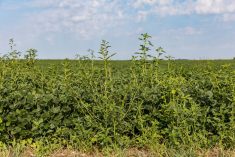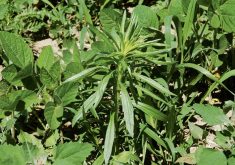How weeds develop resistance to chemical controls is complex – so complex that veteran weed scientist Peter Sikkema wonders whether the herbicide advice he has provided to growers throughout his career has been too general.
Sikkema, recently retired from the University of Guelph’s Ridgetown faculty, shared his perspective on the future of herbicide-based weed control, and the communication of weed control science, at the recent Southwest Agricultural Conference.
He described how our understanding of the mechanisms of resistance — that is, how weeds come to be herbicide resistant — continues to improve, and how herbicides thought to be of no use can sometimes still be very effective.
Read Also

Scientists discover a gene that could triple wheat production
This discovery could give breeders a powerful new tool to boost yields without needing more land, water, or fertilizer.
The trick, he said, is identifying the mechanism by which a given weed population has developed resistance to certain herbicides.
Mechanisms of resistance
Our evolving understanding of herbicide resistance, Sikkema says, is naturally the key factor driving the recommendations given to farmers and agronomists. Those recommendations generally prescribe what herbicide group will or will not work on a given weed.
There are many ways a weed can evolve herbicide resistance. One mechanism of target site resistance is an amino acid substitution, which prevents the production of key amino acids required for protein production. The specific amino acid substitution determines which herbicides are no longer effective for the control.
“There are many ways that weeds evolve resistance to herbicides. The mechanism of resistance may affect which herbicides are still effective. Sometimes herbicides within the same herbicide group are effective,” said Sikkema in response to a later query.
Another mechanism of resistance is enhanced metabolism, where the weed has specific or elevated enzymes conferring resistance to specific herbicides.
Sikkema provided many examples illustrating the complexity of herbicide resistance, including a recent study of Group 5 resistant waterhemp in two Ontario field studies. In one field, a waterhemp biotype was resistant to atrazine. Just 100 metres away, the same waterhemp biotype was effectively controlled with Sencor.
These divergent results came down to the chemical structure of atrazine and Sencor; atrazine has a chlorine atom at the number one position of the phenyl ring, and Sencor does not. The waterhemp biotype had elevated levels of an enzyme which binds to the chlorine atom and metabolizes the herbicide, thus rendering it resistant to the atrazine molecule – but not Sencor.
In contrast, other farms in Ontario contain waterhemp with amino acid substitution, making it resistant to atrazine and Sencor.
“What does this mean on the farm? If you’re the unlucky farmer and have an altered target site, both of the group 5 herbicides fail. In contrast if you’re the [lucky farmer] it’s resistant to atrazine but Sencor still provides control,” said Sikkema.
“I’ll ask the rhetorical question, is it okay for me to say to [the lucky farmer] that he has Group 5 resistant waterhemp, when I know that the Group 5 herbicide Sencor provides excellent control on his farm? In reality, I say there’s Group 5 resistant waterhemp to simplify my message to ensure grower success, even though I know the chemical structure and mechanism of resistance.”
A new understanding
“Have I oversimplified my message?” Sikkema asked, concluding the answer is both yes, and no.
Yes, because speaking only in terms of herbicide groups may unnecessarily limit a growers’ control options.
No, because he has to ensure his message effectively reaches growers, providing them with tangible and effective information that translates to success in the field.
As our scientific understanding of molecular weed science advances, said Sikkema, the information available to make weed management decisions will be ever-more precise. The use of plant tissue analysis with a fast turnaround time, for example, can tell growers the mechanism by resistance allowing them to make informed weed management decisions.
“I think we should continue to be conservative in our message regarding herbicide resistance and assume a weed biotype is resistant to all herbicides within a herbicide group,” said Sikkema. “
Except, where advances in weed science, genomics, the mechanism of resistance and efficacy of active ingredients within a herbicide group are known, it is responsible weed management to use efficacious herbicides within a herbicide group to improve weed control, reduce weed seed additions to the soil weed bank and therefore reduce the likelihood of future herbicide resistant biotypes.”
He concluded by reiterating advances in molecular weed science will allow growers to identify effective herbicide options for the control of herbicide-resistant weeds.
“If science doesn’t move forward, I’m not doing my job.”















